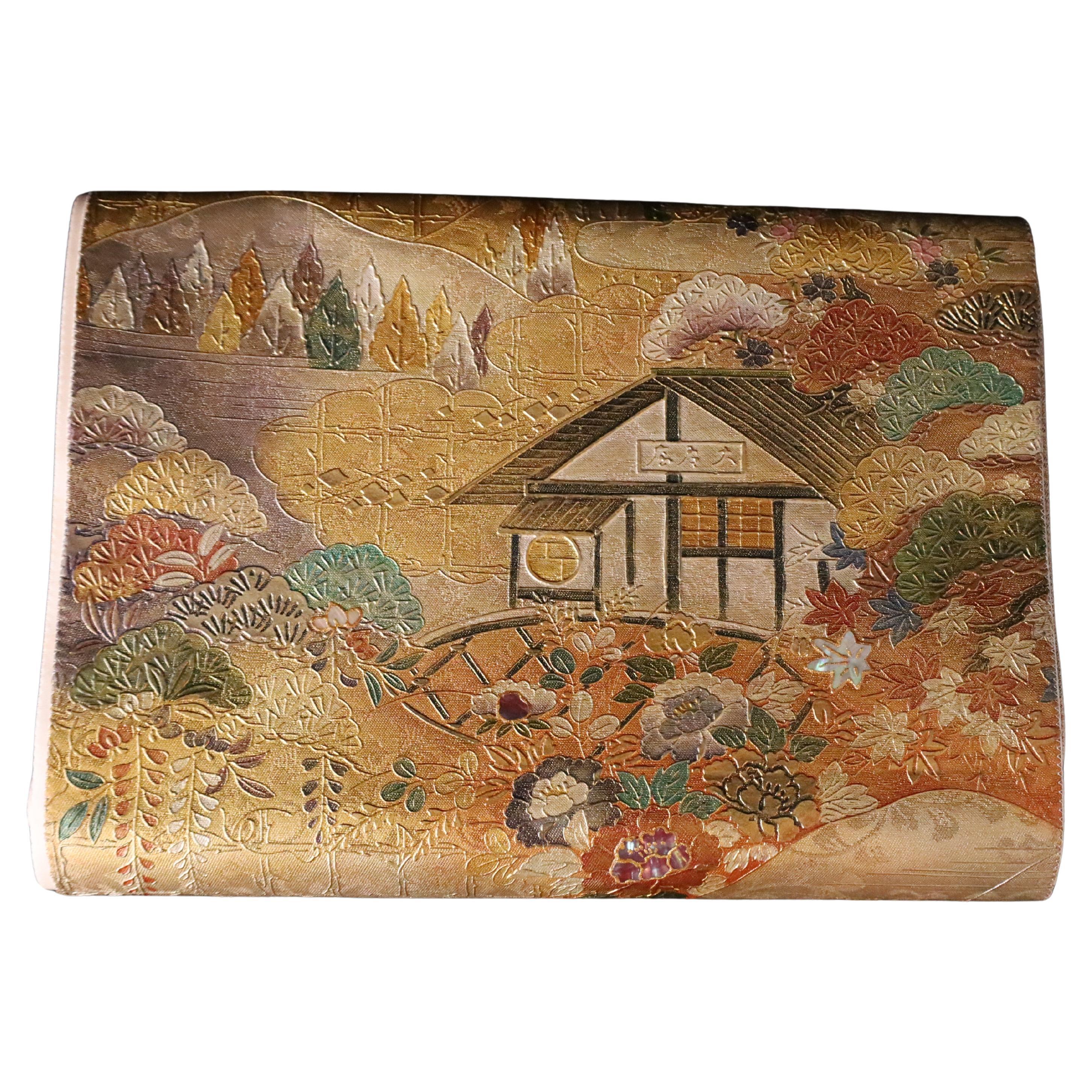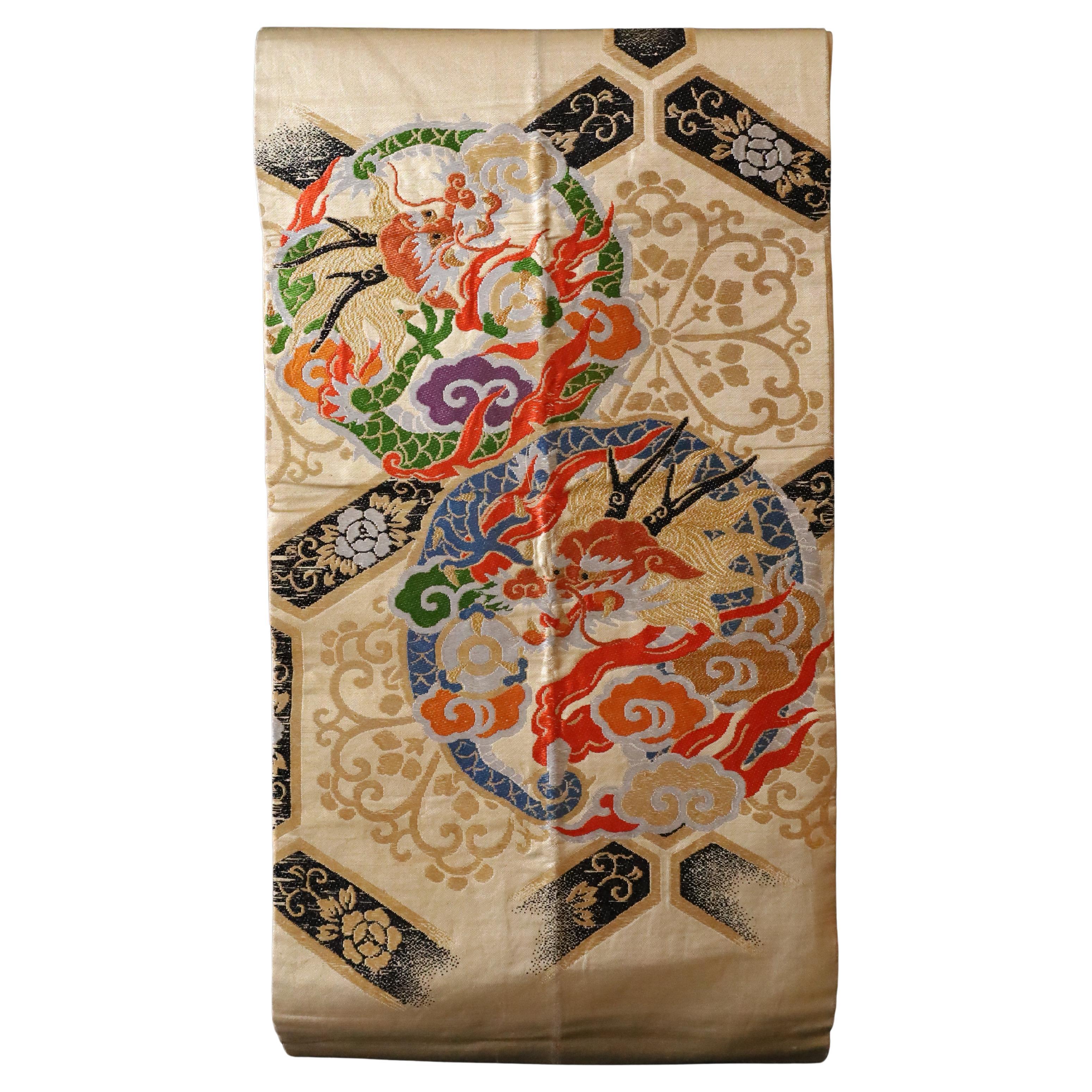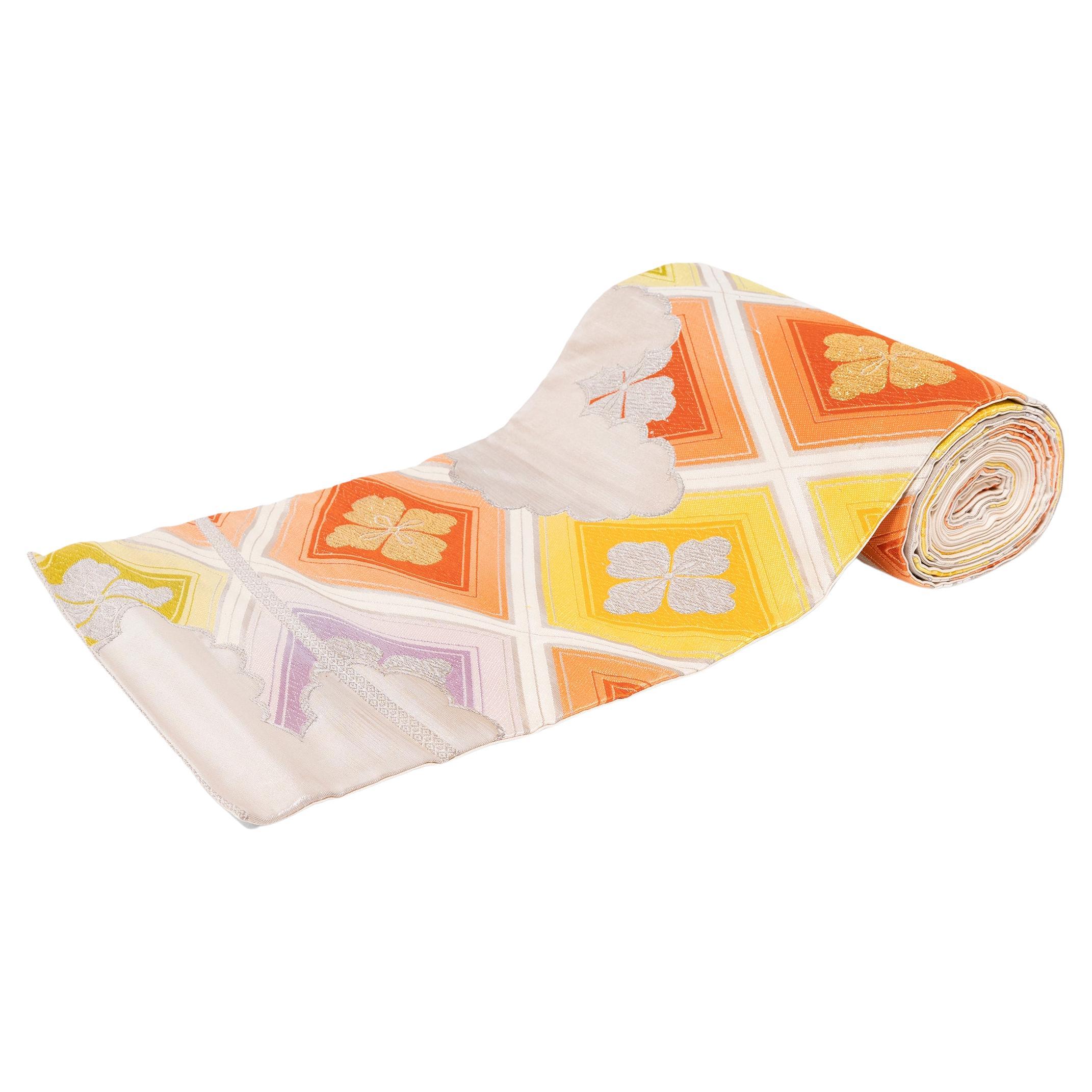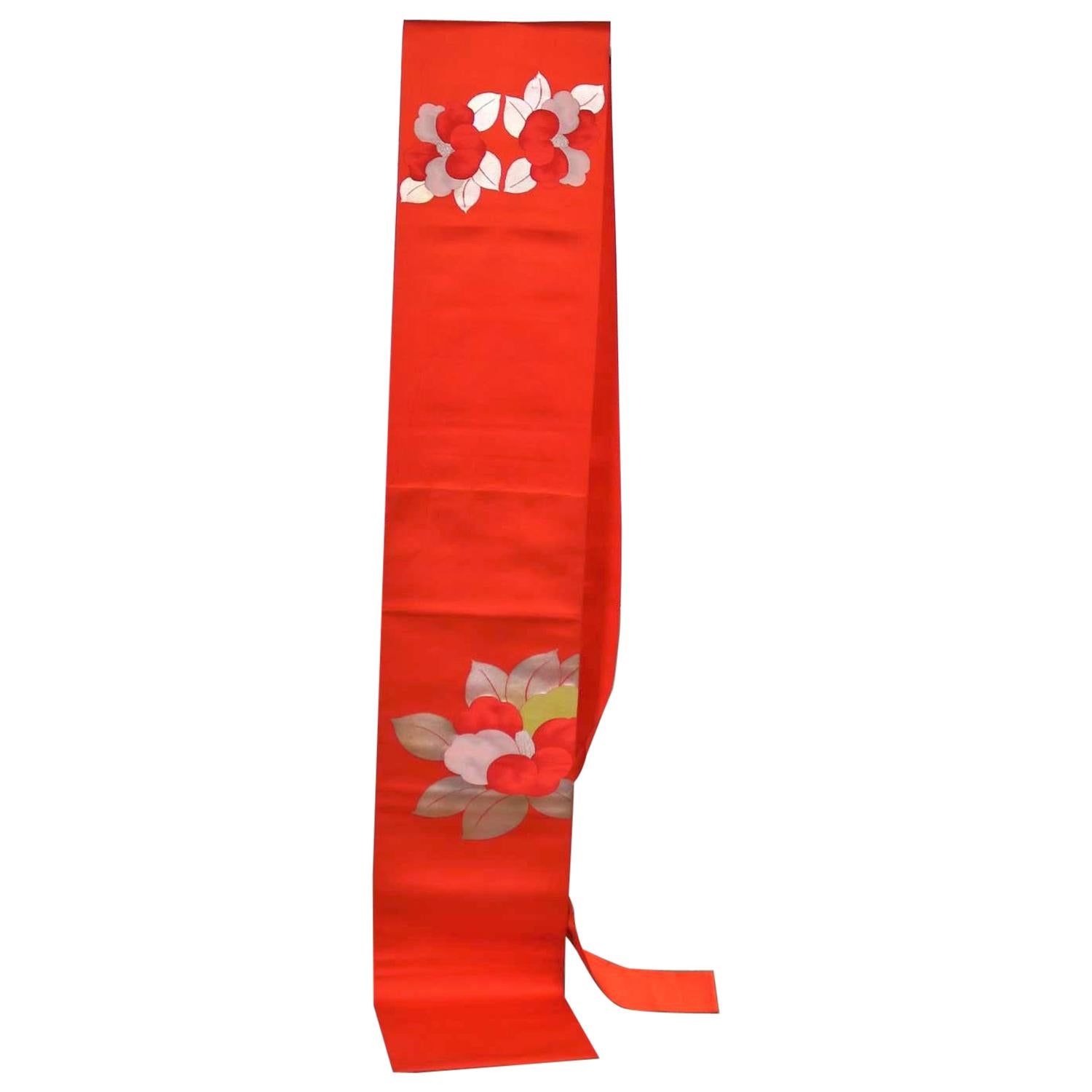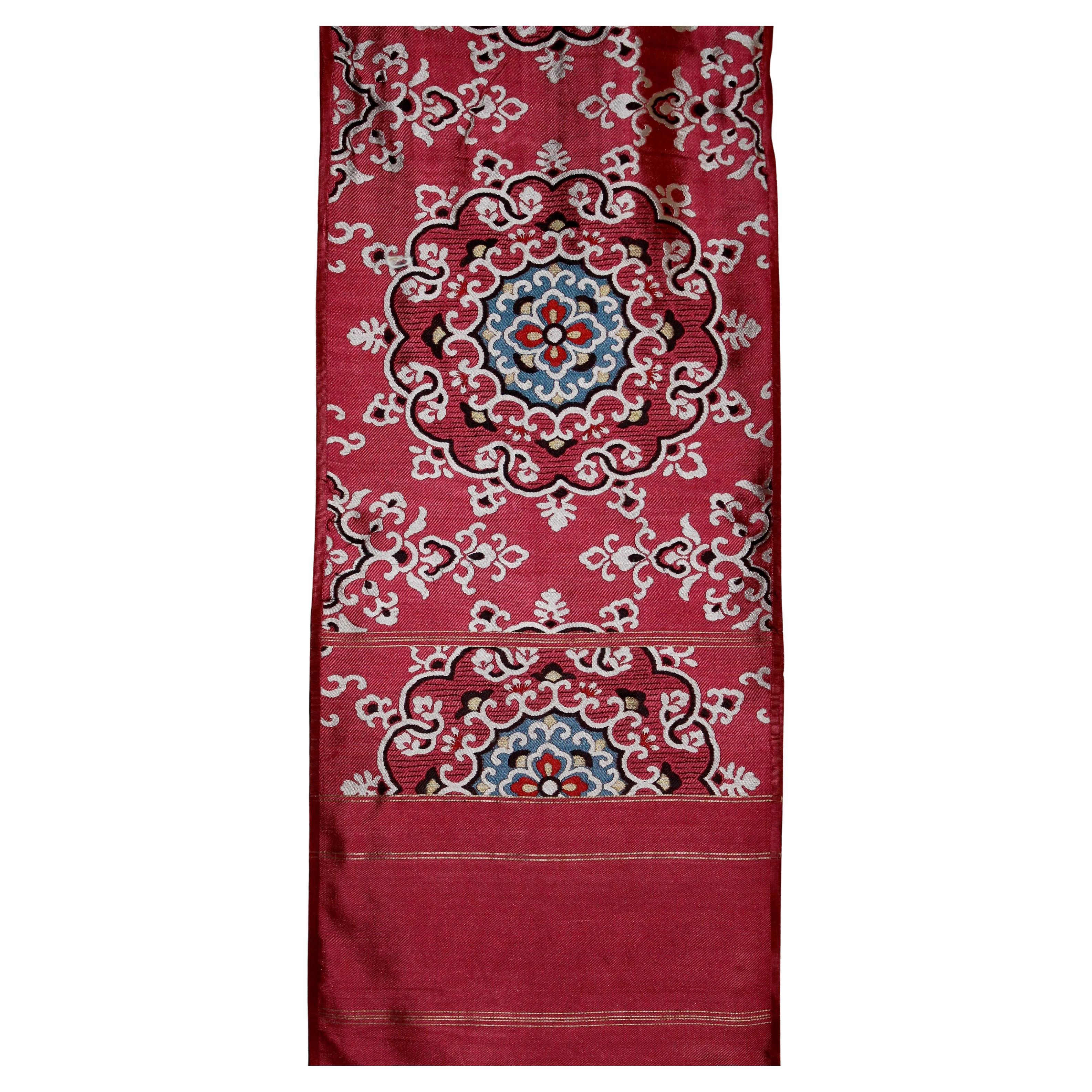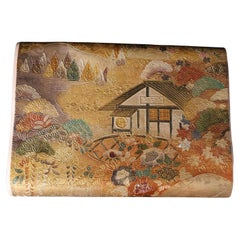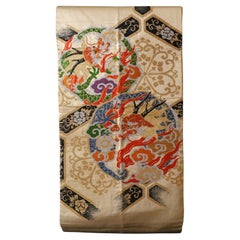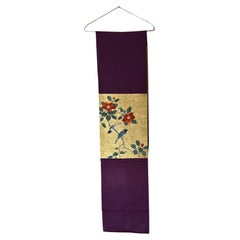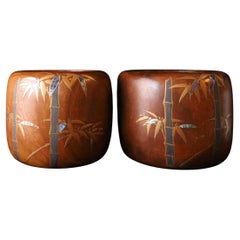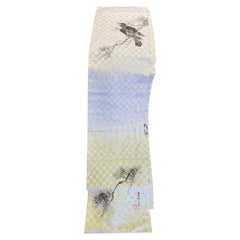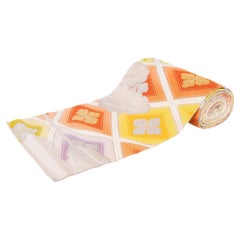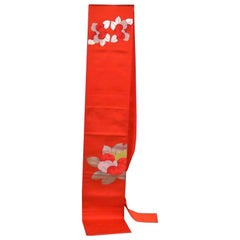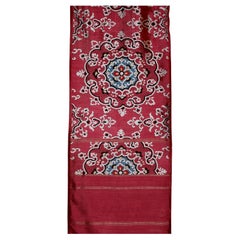Items Similar to Japanese Silk Obi/Table Runner/Wall decoration with Peony Motif
Want more images or videos?
Request additional images or videos from the seller
1 of 17
Japanese Silk Obi/Table Runner/Wall decoration with Peony Motif
$520
£394.56
€451.15
CA$726.30
A$807.55
CHF 421.66
MX$9,829.80
NOK 5,380.14
SEK 5,040.94
DKK 3,367.01
Shipping
Retrieving quote...The 1stDibs Promise:
Authenticity Guarantee,
Money-Back Guarantee,
24-Hour Cancellation
About the Item
apanese Silk Obi Table Runner with Peony Motif
Japan, 20th century
Dimensions: 440 × 32 cm
This luxurious silk obi has been repurposed into an elegant table runner. Woven with shimmering metallic threads, it features a spectacular peony motif—a traditional Japanese symbol of beauty, prosperity, and honor. The vibrant red, green, and gold threads catch the light, creating a dramatic effect against the black background.
The bold scale of the pattern and the use of rich silk and gold threads suggest that this obi was originally part of a formal kimono ensemble, possibly for ceremonial occasions. Now, it brings timeless Japanese refinement to any interior as a decorative textile.
About the Seller
No Reviews Yet
Vetted Professional Seller
Every seller passes strict standards for authenticity and reliability
Established in 2023
1stDibs seller since 2024
8 sales on 1stDibs
Typical response time: 13 hours
- ShippingRetrieving quote...Shipping from: Fukuoka, Japan
- Return Policy
Authenticity Guarantee
In the unlikely event there’s an issue with an item’s authenticity, contact us within 1 year for a full refund. DetailsMoney-Back Guarantee
If your item is not as described, is damaged in transit, or does not arrive, contact us within 7 days for a full refund. Details24-Hour Cancellation
You have a 24-hour grace period in which to reconsider your purchase, with no questions asked.Vetted Professional Sellers
Our world-class sellers must adhere to strict standards for service and quality, maintaining the integrity of our listings.Price-Match Guarantee
If you find that a seller listed the same item for a lower price elsewhere, we’ll match it.Trusted Global Delivery
Our best-in-class carrier network provides specialized shipping options worldwide, including custom delivery.More From This Seller
View AllJapanese Obi with Landscape and Pavilion Motif – wall decoration, table runner
Located in Fukuoka, JP
A stunning Japanese obi textile from the Shōwa period, masterfully woven from silk with exquisite raden (mother-of-pearl inlay) detailing. This formal maru obi features a rich and in...
Category
20th Century Japanese Showa Textiles
Materials
Silk
Japanese Maru Obi with Gold Embroidered Dragons – Silk Brocade, Taisho to Showa
Located in Fukuoka, JP
A magnificent example of Japanese textile artistry, this vintage maru obi dates from the Taisho to early Showa period (circa 1920–1950). Woven in luxurious silk, it features a richly detailed brocade design with mythological dragons encircled by flames and stylized clouds—symbols of strength, protection, and imperial authority in Japanese culture.
The opulent gold and beige ground is accented with bold tones of red, green, black, and purple, showcasing intricate weaving techniques and vibrant color contrasts. Hexagonal panels with floral motifs in gold and black add structure and visual rhythm to the piece. Measuring 341 cm in length and 32 cm in width, this maru obi was traditionally worn for formal kimono occasions and would have wrapped fully around the waist.
Today, it makes a powerful statement as a display piece—whether mounted as wall art or draped as a textile sculpture—highlighting the beauty and craftsmanship of early 20th-century Japanese weaving...
Category
20th Century Japanese Showa Textiles
Materials
Cotton, Silk
Antique Japanese Obi Textile Panel with Birds and Camellia Flowers, Meiji Period
Located in Fukuoka, JP
A magnificent antique Japanese silk obi fragment from the Meiji period (1868–1912), showcasing exceptional hand embroidery and gold leaf overlay.
This refined textile features a pai...
Category
Antique 19th Century Japanese Meiji Textiles
Materials
Silk
Pair of Japanese Hibachi with Inlaid Bamboo Motif
Located in Fukuoka, JP
A beautifully matched pair of Japanese hibachi (traditional fire bowls) from the Meiji period (1868–1912), showcasing exceptional craftsmanship and refined aesthetics. Each vessel is...
Category
Early 20th Century Japanese Taisho Lacquer
Materials
Wood
Japanese Bamboo Ikebana Basket with Handle, Showa Period
Located in Fukuoka, JP
A refined Japanese ikebana basket, expertly handwoven from split bamboo with a tall, cylindrical body and elegantly arched handle crafted to resemble natural bamboo stalks. The baske...
Category
20th Century Japanese Showa Decorative Baskets
Materials
Bamboo
Small Japanese Bronze Vase with Warm Patina, 20th Century
Located in Fukuoka, JP
This compact Japanese bronze vase charms with its classic silhouette and richly mottled patina in warm reddish-brown tones. The subtle variations in the surface evoke the organic bea...
Category
20th Century Japanese Showa Metalwork
Materials
Bronze
You May Also Like
Japanese Signed Stamped Hand Drawn Silk Obi Sash Belt with Crow, Mid-1900
Located in Studio City, CA
A wonderful handmade vintage silk Obi sash/ belt featuring a rather unique hand-drawn scene with a crow and trees.
Signed and stamped by the artist...
Category
Mid-20th Century Japanese Showa Textiles
Materials
Silk
Japanese Flower Diamond Obi
Located in Chicago, IL
This finely woven Japanese silk obi exudes opulence and femininity. Typically made of fine silks with rich embroidery, the obi is a decorative sash w...
Category
20th Century Japanese Textiles
Materials
Silk
Vintage Orange Silk Japanese Obi with Gold and Silver Lamé and Brocade
Located in Topeka, KS
Handsome vintage Japanese obi in orange silk with gold and silver lamé and brocade flower and leaf design. It is in wonderful vintage condition. We have detected a small dark spot on...
Category
Mid-20th Century Japanese Japonisme Tapestries
Materials
Silk
Signed Silk Brocade Obi
Located in Sharon, CT
Very large (188") hand woven silk brocade Obi.
Category
Antique Late 19th Century Japanese Meiji Textiles
Materials
Silk
$2,500
Vintage Japanese Formal Black Silk Kimono with Pheonix Embroidery
Located in Atlanta, GA
A vintage Japanese silk Kuro Tomesode Kimono, circa 1950s-1980s. Kuro Tomesode is a dress for married woman for the most formal occasions, equivalent of the evening gowns in the west. It is overall black, decorated only with patterns of bright colors on the bottom. This kimono has three Mon family crests on the front and back shoulder. It is lined with white silk in its interior. On the front, it features exposed white stitches around neck and breast, a very subtle and elegant touch. The bottom part of the kimono is decorated with an embroidery imagery of two phoenix in flight. The lavish use of gold and polychrome threads and meticulous rendition of the birds contrast greatly with the otherwise sober black background. Pheonix is the mythical bird traditionally represents the Queen or Female Supreme in Chinese culture. Known as Hoo-oo in Japanese, Pheonix is a symbol of good fortune, power and divine wisdom and represents the sun goddess Amaterasu, the Queen of Heaven and Creation, who was believed to be the ancestor of the lines of the Japanese imperial family...
Category
Mid-20th Century Japanese Showa Textiles
Materials
Silk
Old Japanese Kimono / 1912-1945 / Wall Hanging Decoration / Tapestry
Located in Sammu-shi, Chiba
I think this is a kimono woven from the Taisho era to the early Showa era (1912-1945) in Japan.
It is a modern design.
In the Taisho era, various things were made with reference to...
Category
Early 20th Century Japanese Taisho Tapestries
Materials
Cotton
